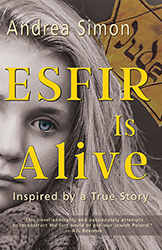Earlier this week, Andrea Simon’s wrote about transforming her family memoir into a novel, which was published earlier this month: Esfir Is Alive. Andrea is guest blogging for the Jewish Book Council all week as part of the Visiting Scribe series here on The ProsenPeople.
As a writer, I’m drawn to autobiographical events for inspiration. I use old photos as reference material, I conduct interviews and record conversations, I comb through letters and official documents. I’m a stickler for getting things right. I once drove a hundred miles to check out the road sign that appeared in a story to see if it read “Fallen Rock Zone” or “Falling Rock Zone” — and when I found both signs in similar locations, I flipped a coin and convinced myself that no sane person would ever check such a detail.
Non-evidentiary materials, especially remembrances, are harder to verify. When I once gave a coming-of-age novel to my childhood friend Joanie to read for accuracy, she wrote several times in the margins, “Oh, I remember that.” In those instances she was wrong: they had been manufactured. What Joanie recalled was more of a truthful impression of our childhood rather than a factual representation. From her reaction, I knew I was onto something.
In that book, I wrote about a girl named Amanda who overhears adults talking about a disturbing incident. In my memory, I had gone to hide in the woods; in the novel, Amanda turns in the other direction, heading to the drugstore to order an egg cream. This Amanda, I soon discovered, was not me; she would lead her own life. And the older I get, nonfiction and fiction are so intertwined in my stories that I often forget what really happened.
In writing historical fiction, the author has even more pressing obligations. I longed to tell the story about my uncle Abraham, a World War II navigator killed in 1943 with eleven crew members aboard a B‑17 Flying Fortress on a training mission in Florida. A reverential family figure, he seemed “too good to be true.” I set out to animate him into someone I could call my own. But history beckoned. I read manuals on the B‑17, poured over personal narratives of service people, downloaded photos of Florida in the 1940s, and even attended a World War II aviation exhibition, crawling into the body of a Flying Fortress. I imagined the thrill of directing one’s course through the sky and the loneliness of being away from home.
Before long, my fictional Abraham spent a day off from flying at a local plantation where local black community members were reenacting slavery. A Jew in the South, Abraham became a man immersed in racism and prejudice. I gave the story to an aviation expert who found no technical mistakes, and was impressed by the personality of the protagonist. To him, Abraham was a real man. To me, he was alive for the first time.
 My latest novel, Esfir Is Alive, was inspired by the true story of a twelve-year-old survivor of a Holocaust massacre and my ancestral family in a Belorussian village. In tackling such an immense tragedy, I had two guiding principles: whatever Esfir did, it had to be within the realm of her personality, and whatever happened in the novel had to accurately reflect the events of the time. If my fictional characters were to be viable, they had to make their own decisions. If I could accomplish these lofty goals, the reader would feel “the truth” as my friend Joanie had years before.
My latest novel, Esfir Is Alive, was inspired by the true story of a twelve-year-old survivor of a Holocaust massacre and my ancestral family in a Belorussian village. In tackling such an immense tragedy, I had two guiding principles: whatever Esfir did, it had to be within the realm of her personality, and whatever happened in the novel had to accurately reflect the events of the time. If my fictional characters were to be viable, they had to make their own decisions. If I could accomplish these lofty goals, the reader would feel “the truth” as my friend Joanie had years before.
Although my mother did not live to read my novel about Esfir, I think that she would have approved. She may have said that she did not remember my family’s village, which she visited as a child, to be exactly as I describe. But I think she would have agreed that even though Esfir hadn’t been a real member of our family, she was a true Jewish girl of her time.
Andrea Simon is the author of the memoir Bashert: A Granddaughter’s Holocaust Quest, the new novel Esfir Is Alive, and several stories and essays. She holds an MFA in Creative Writing from the City College of New York and lives in New York City.
Related Content:
- Nancy Richler: Deciding to Forgo Research
- Haim Watzman: How to Succeed in Academia Without Doing Any Research
- Janis Cooke Newman: Why I Write Historical Fiction
Andrea Simon is the author of the memoir BASHERT:, A GRANDDAUGHTER’S HOLOCAUST QUEST, her recent novel ESFIR IS ALIVE, and several published stories and essays. The recipient of numerous literary awards, Andrea holds an MFA in Creative Writing from the City College of New York where she has taught writing. She lives in New York City.




